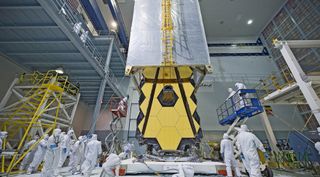No Damage to James Webb Space Telescope After Vibration Test Anomaly

SANTA FE, N.M. — NASA's James Webb Space Telescope shows no signs of damage after an "anomaly" during a vibration test earlier in the month, the agency announced Dec. 23.
In a statement posted on the JWST website, NASA said that engineers were making progress tracking down the root cause of the Dec. 3 incident that halted vibration testing of the telescope's mirror assembly and instruments, known as the Optical Telescope element and Integrated Science (OTIS).
"All visual and ultrasonic examinations of the [telescope] structure continue to show it to be sound," NASA said in the update. "Currently, the team is continuing their analyses with the goal of having a review of their findings, conclusions and plans for resuming vibration testing in January." [In Pictures: Building NASA's James Webb Space Telescope]
The OTIS assembly, which includes the telescope's 6.5-meter segmented primary mirror, secondary mirror and associated structures, and its suite of four science instruments, were undergoing vibration testing at the Goddard Space Flight Center Dec. 3 when engineers detected "anomalous readings" from accelerometers attached to the telescope. NASA halted the vibration tests to study the data as well as inspect the telescope for any damage.
NASA has not provided additional details on the nature of the vibration anomaly. The agency said in its latest update that, since the anomaly, the spacecraft team "successfully conducted two low level vibrations of the telescope."
The vibration tests, as well as planned acoustic tests, are designed to simulate the environment JWST will experience during its launch on an Ariane 5 in late 2018. "We are about to subject this beautiful beast, which is finished, to see if it will survive launch," said John Mather, the JWST senior project scientist, at a Nov. 2 media event at Goddard about the telescope. "We expect it to, but we still have to prove it."
It's unclear that effect the delay in the vibration and acoustic testing will have on JWST's schedule. At the November event, Bill Ochs, NASA JWST project manager, said plans then called for shipping OTIS in February to the Johnson Space Center, where it will undergo thermal vacuum tests in a refurbished Apollo-era chamber there. It would then go in mid-2017 to a Northrop Grumman facility in Southern California to be integrated with the spacecraft bus and sunshield, and then undergo further testing before shipping to the French Guiana launch site in mid-2018.
Get the Space.com Newsletter
Breaking space news, the latest updates on rocket launches, skywatching events and more!
However, project officials have emphasized that JWST has healthy schedule reserves put into place after a "replan" of the project in 2011, when cost and schedule overruns threatened JWST with cancellation. Those reserves are intended to mitigate any effect on the mission's overall schedule from testing delays.
The replan provided JWST more schedule margin than required for a typical NASA project "because it's Webb and we knew there would be additional complications," said Scott Willoughby, Northrop Grumman vice president and program manager for JWST, in an interview at the Nov. 2 NASA event. "We're right in line to where we need to be at this point in time, with two years to go before launch."
This story was provided by SpaceNews, dedicated to covering all aspects of the space industry.
Join our Space Forums to keep talking space on the latest missions, night sky and more! And if you have a news tip, correction or comment, let us know at: community@space.com.

Jeff Foust is a Senior Staff Writer at SpaceNews, a space industry news magazine and website, where he writes about space policy, commercial spaceflight and other aerospace industry topics. Jeff has a Ph.D. in planetary sciences from the Massachusetts Institute of Technology and earned a bachelor's degree in geophysics and planetary science from the California Institute of Technology. You can see Jeff's latest projects by following him on Twitter.
Most Popular



